Once a relative rarity, ceramics have today been firmly established as go-to materials in the luxury watch industry, alongside traditional metals such as gold, steel, and titanium. But no single watchmaker is more associated with ceramics in the horological realm than Rado, which has not only made the tough, scratchproof, hypoallergenic material a core part of its identity but continues to pioneer new frontiers in what can be done with it. Here’s the story behind Rado’s host of technical innovations, from early “hardmetal” alloys to today’s signature high-tech ceramic, and how two of the brand’s milestones from 1962 have become inextricably linked in the modern era.
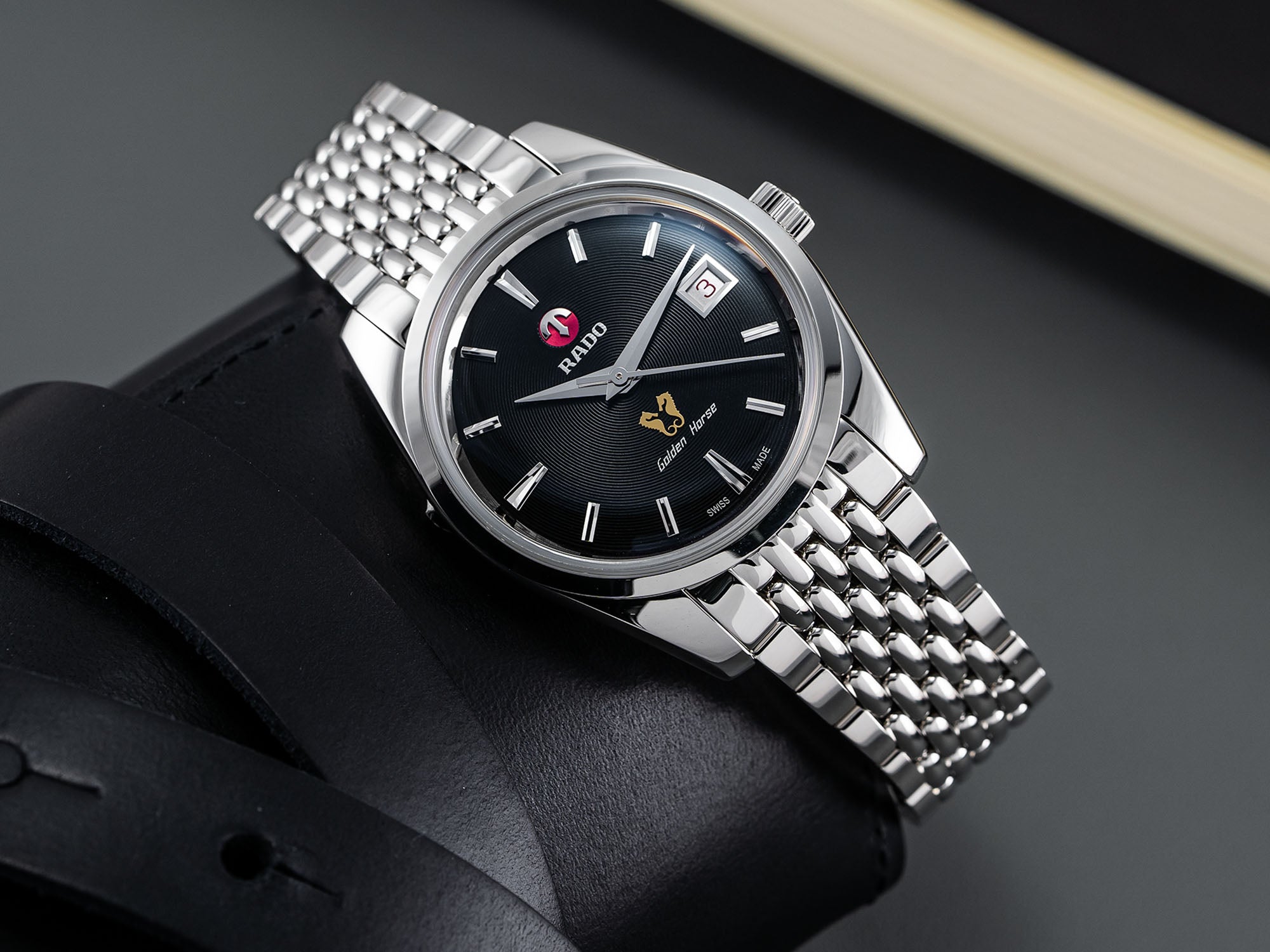
From DiaStar to Diver's Watch
Rado was founded in 1917 by brothers Fritz, Ernst, and Werner Schlup, who converted their parents’ home in Lengnau, in the Swiss canton of Bern, into a watch factory. Originally dubbed Schlup & Co.,the family firm started out making movements, becoming an important supplier during the World War II years. Forty years after its foundation, in 1957, the company launched the Rado watch brand, taking its name from the Esperanto word for “wheel.” The very first timepiece made under the new Rado banner was the Golden Horse (modern tribute model above), which was also one of the first wristwatches marketed with an emphasis on its antimagnetic properties. It was the harbinger of the technical innovation that the company would adopt as part of its stock-in-trade going forward.
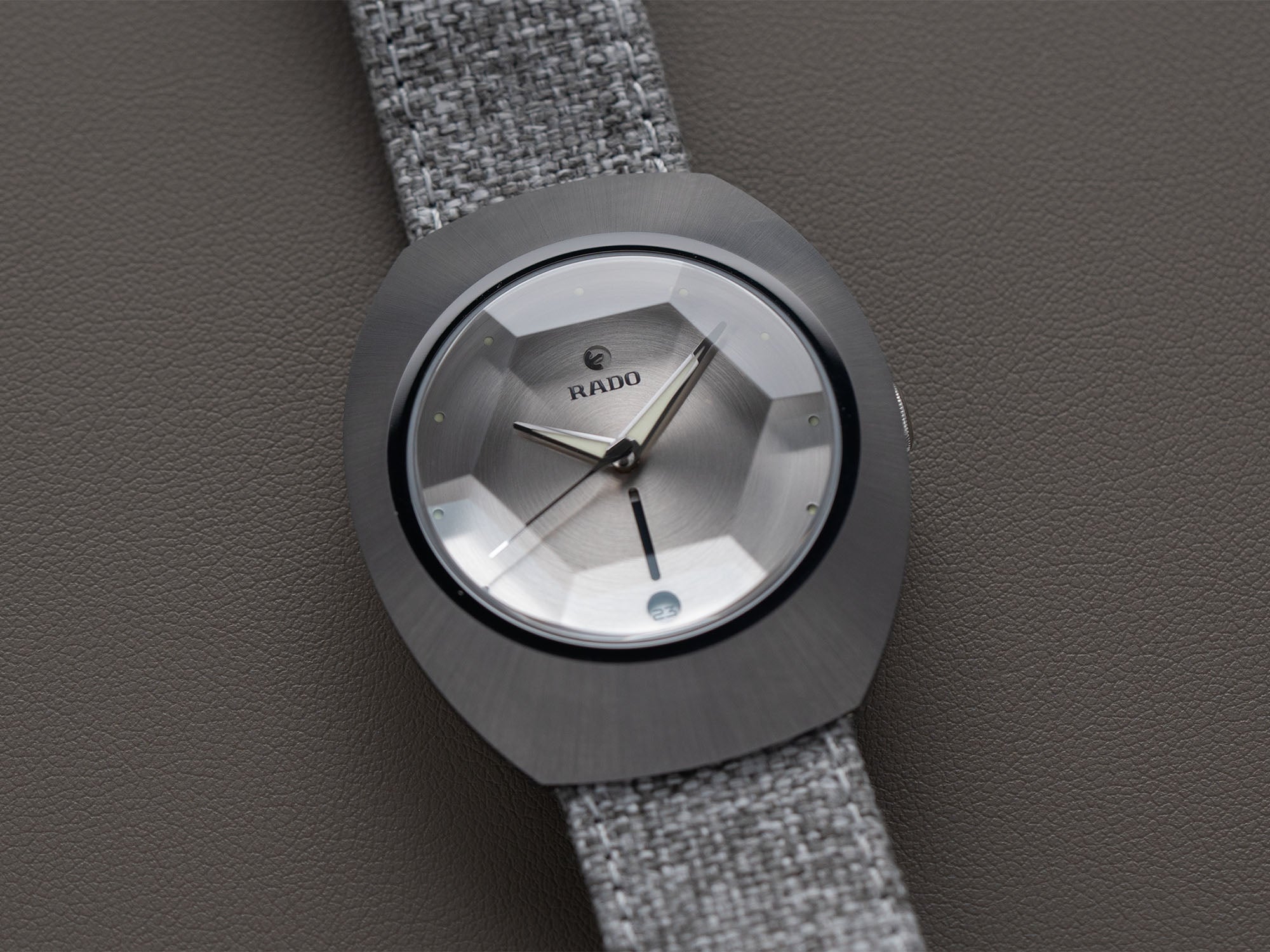
In 1962, a scant five years after the release of the Rado Golden Horse, the young company achieved a pair of milestones that helped lay out the path for its future. The one that made the most immediate impact was the launch of a watch called the DiaStar 1 (60th anniversary tribute edition pictured above), which Rado touted as “the world’s first scratch-proof watch” — and also one of the first to use sapphire for its crystal rather than the mineral glass that was more common at the time. (You can delve further into the history of sapphire in watchmaking in this article.) It had a case and bracelet made from tungsten carbide “hardmetal,” which was not a pure ceramic but actually a metal/ceramic hybrid (aka a “metal matrix composite”), which blends tungsten and carbon elements and has many metallic properties. Used in the manufacture of products like drill bits and surgical tools, it was nevertheless a rare material to find in a wristwatch in the 1960s, and the DiaStar set the stage for further developments in the area of ceramics — defined fairly loosely as a hard, brittle, heat-resistant and corrosion-resistant material made from firing an inorganic, non-metallic material at high temperatures.

Rado’s other notable release in 1962 was its first purpose-built divers’ watch, the Rado Captain Cook, which took its name from the 18th-century British explorer, cartographer and naval officer James Cook and whose notable attributes included a metal “beads-of-rice” bracelet (re-created on the model above), an inward-sloping, unidirectionally rotating dive-scale bezel, and the embossed pair of seahorses on its caseback. The term “notable” in this case, however, comes with a caveat: Released nearly a decade after such genre-defining dive watches as the Rolex Submariner and Blancpain Fifty Fathoms, the Captain Cook did not make much of a splash (pun intended) initially, struggling to find a receptive audience in an era that was already well saturated with affordable alternatives to the big two. Only about 8,000 pieces were made, and Rado discontinued the model in 1968; the Captain Cook’s second act, nearly 50 years later, would prove to have much more staying power.
The Road to High-Tech Ceramic
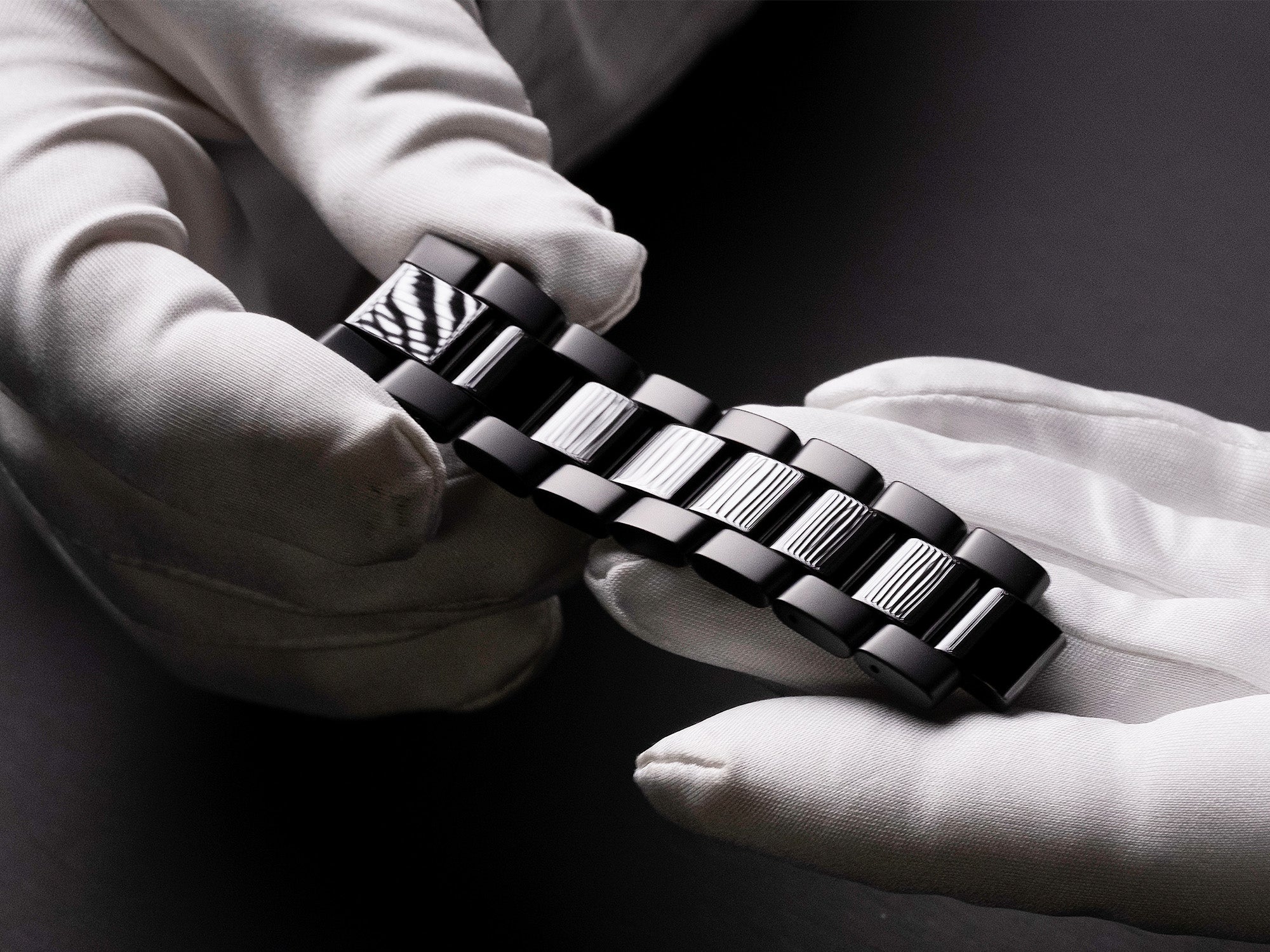 Rado’s experiment with the DiaStar 1 spurred several decades of research and development into ceramics in watchmaking, yielding innovations like the use of polymer binding agents to allow injection-molding, and the introduction of a titanium nitride-based CVD treatment that allowed for uncommonly resistant finishes that emulated metals such as gold. Rado was also one of the first watch manufacturers to introduce sapphire glass crystals into its regular production, as early as the 1970s, years before it became standard in the luxury watch industry. All of this work led to Rado’s signature achievement in 1986, its development of watch parts made of “high tech” ceramic.
Rado’s experiment with the DiaStar 1 spurred several decades of research and development into ceramics in watchmaking, yielding innovations like the use of polymer binding agents to allow injection-molding, and the introduction of a titanium nitride-based CVD treatment that allowed for uncommonly resistant finishes that emulated metals such as gold. Rado was also one of the first watch manufacturers to introduce sapphire glass crystals into its regular production, as early as the 1970s, years before it became standard in the luxury watch industry. All of this work led to Rado’s signature achievement in 1986, its development of watch parts made of “high tech” ceramic.

High-tech ceramic differs from more common ceramic compounds in both the ingredients and processes used to make it and in the properties achieved by the finished material. It starts with a mixture of aluminum oxide, zirconium oxide, and silicon nitride, all in powders of perfectly uniform grain sizes, which are shaped into a particular form and baked at extremely high temperatures. The powders (above) are mixed with a specially developed plastic carrier agent before being injected into a mold at super-high pressures up to 1,000 bar. (The “hardmetal” material that preceded it, by contrast, used ultra-fine tungsten carbide powder, a metal binder, and a plastic carrier agent.)
 After cooling from this first firing, the pieces are removed from the mold and undergo exposure to a chemical solvent that dissolves the carrier agent before a final phase of sintering (i.e., both heat and pressure treatment) at 1,450º Celsius; the result is a material that is harder, denser, and yet lighter than traditional ceramics, which can still stand up to the diamond-tipped-tool machining and finishing (above) required for high-end watch case manufacturing. High-Tech Ceramic rates 1,250 on the Vickers hardness scale; by way of comparison, gold is 150 and stainless steel is 200. The process from which the material emerges creates additional attributes, i.e., eliminating the porosity and fragility that is characteristic of more conventional ceramics.
After cooling from this first firing, the pieces are removed from the mold and undergo exposure to a chemical solvent that dissolves the carrier agent before a final phase of sintering (i.e., both heat and pressure treatment) at 1,450º Celsius; the result is a material that is harder, denser, and yet lighter than traditional ceramics, which can still stand up to the diamond-tipped-tool machining and finishing (above) required for high-end watch case manufacturing. High-Tech Ceramic rates 1,250 on the Vickers hardness scale; by way of comparison, gold is 150 and stainless steel is 200. The process from which the material emerges creates additional attributes, i.e., eliminating the porosity and fragility that is characteristic of more conventional ceramics.
New Frontiers: Plasma, Ceramos, & Polychromatic Color
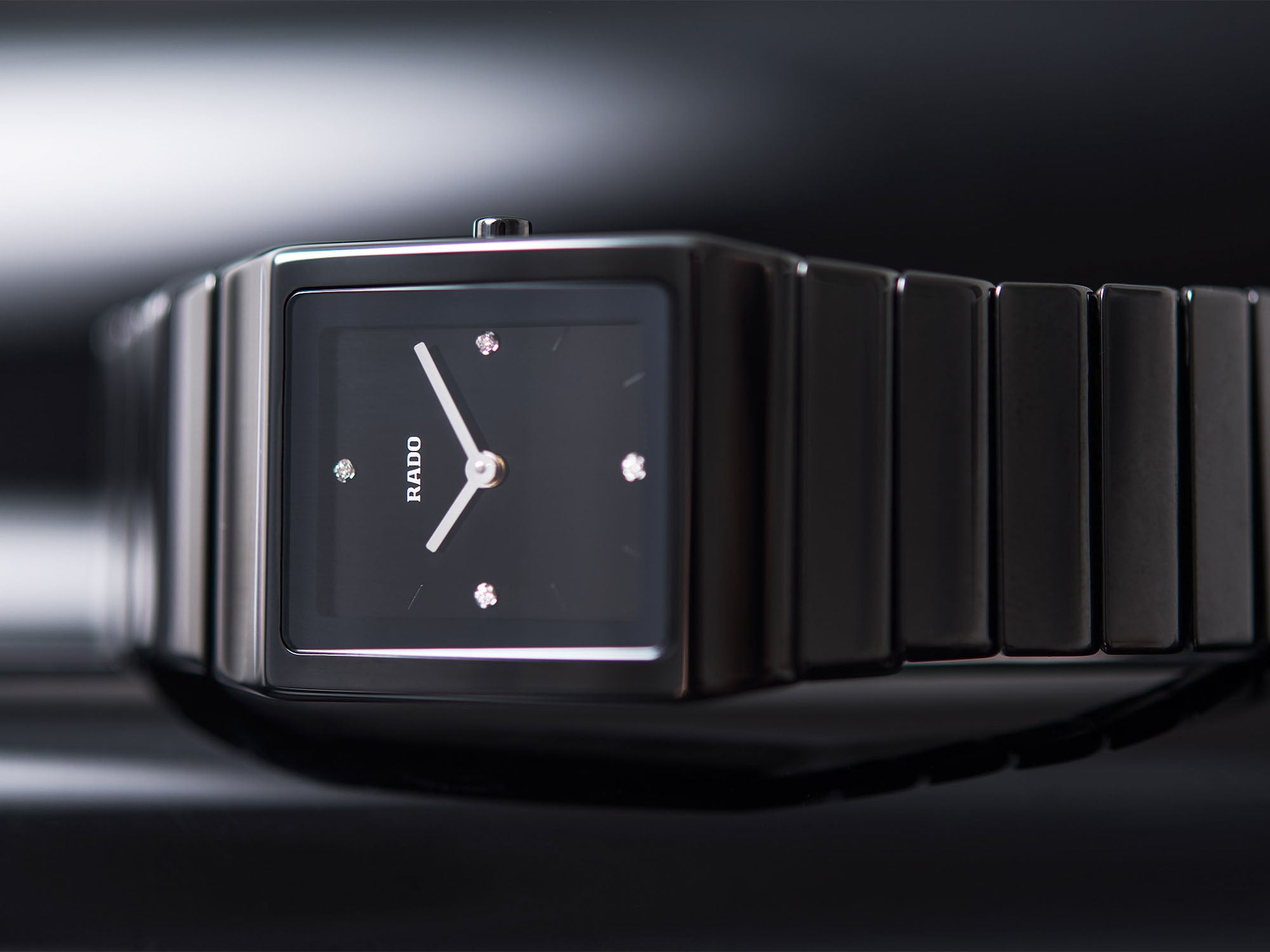
Rado introduced its creation in a watch called the Integral, also in 1986 (perhaps not entirely coincidentally, the year that Rado became part of the Swatch Group and gained access to greater financial support for its initiatives). That short-lived model — whose rectangular case shape echoed those of fashion-forward 1970s predecessors like the Elegance and Glissière — ushered in the milestone timepiece that debuted four years later, the aptly named Rado Ceramica (above), which was noteworthy for its minimalist design, its square-shaped black case, and its bracelet, composed of individual bricks of solid ceramic.
 While IWC’s Da Vinci Perpetual Calendar, released one year earlier, had preceded the Ceramica to market as the first watch with a case made of “real” ceramic (aka zirconium oxide), the Ceramica was the first to use any type of ceramic for both its case and bracelet. (You can read more about the evolution of ceramics in watchmaking here.) The next generation of the Ceramica, introduced in 1998, introduced another new material developed by the team in Lengnau: plasma high-tech ceramic, which is visually nearly indistinguishable from metal and derives its properties from exposure to gasses activated by plasma discharges inside a 20,000º Celsius oven (above) that heats the ceramic itself to extreme temperatures as high as 900º Celsius.
While IWC’s Da Vinci Perpetual Calendar, released one year earlier, had preceded the Ceramica to market as the first watch with a case made of “real” ceramic (aka zirconium oxide), the Ceramica was the first to use any type of ceramic for both its case and bracelet. (You can read more about the evolution of ceramics in watchmaking here.) The next generation of the Ceramica, introduced in 1998, introduced another new material developed by the team in Lengnau: plasma high-tech ceramic, which is visually nearly indistinguishable from metal and derives its properties from exposure to gasses activated by plasma discharges inside a 20,000º Celsius oven (above) that heats the ceramic itself to extreme temperatures as high as 900º Celsius.
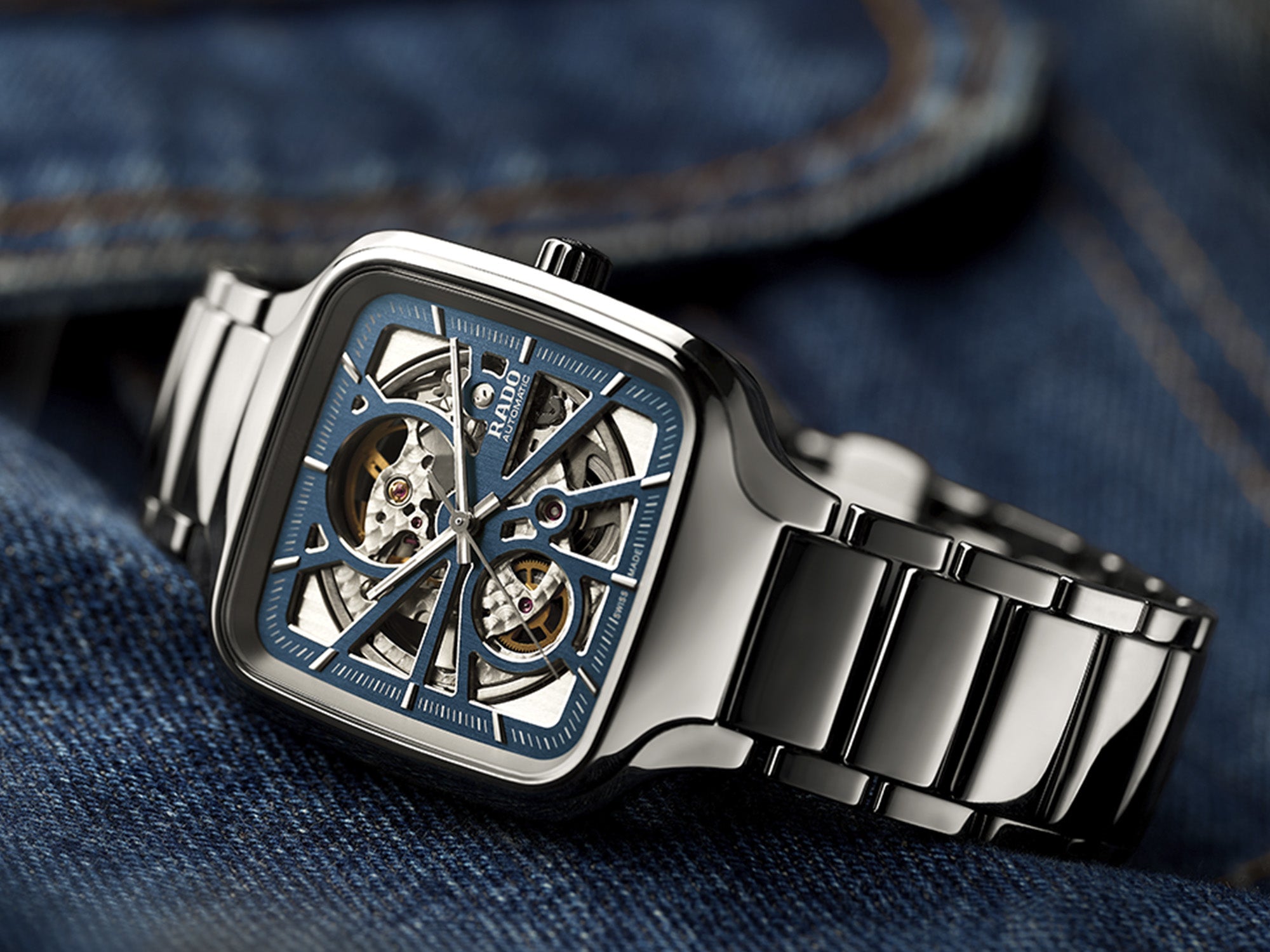
The Ceramica — and other bold experiments like 2002's V10K, an all-black timepiece with a hardmetal case coated with "high-tech" diamond, measuring an unprecedented 10,000 on the Vickers scale — were niche products with a limited audience but they heralded numerous Rado watches that adopted elements of their design as well as avant-garde materials. Collections like the original Rado True in a round case, launched in 2011; the True Square (introduced in 2020); and True Square Open Heart (2021, above) combine elegantly slender monobloc cases and bracelets, both made entirely from high-tech ceramic, with an understated aesthetic and, increasingly, an array of colorways scarcely seen throughout the rest of the watch world thanks to the versatility of their materials. In addition to its other properties described previously, zirconium oxide can be crafted in a range of colors and finished in either a polished or matte surface. Perhaps the most striking examples of Rado’s mastery of the process can be found in 2011’s True Thinline Les Couleurs Le Corbusier series, made in an exclusive partnership with the foundation of Charles-Edouard Jeanneret, aka Le Corbusier (1887-1965), the French-Swiss architect known as “the father of modernism.” Each of the watches’ monobloc cases and bracelets are executed in one of nine colors from Le Corbusier’s Architectural Polychromy; composed of 63 total colors, it is regarded as the ultimate color system for architectural and interior design. Outfitted with Swiss quartz movements, behind titanium casebacks, the True Thinline watches offer a wide range of distinctive pastel shades: cream white, pale sienna, luminous pink, slightly greyed English green, sunshine yellow, powerful orange, spectacular ultramarine, grey brown natural umber, and iron grey.
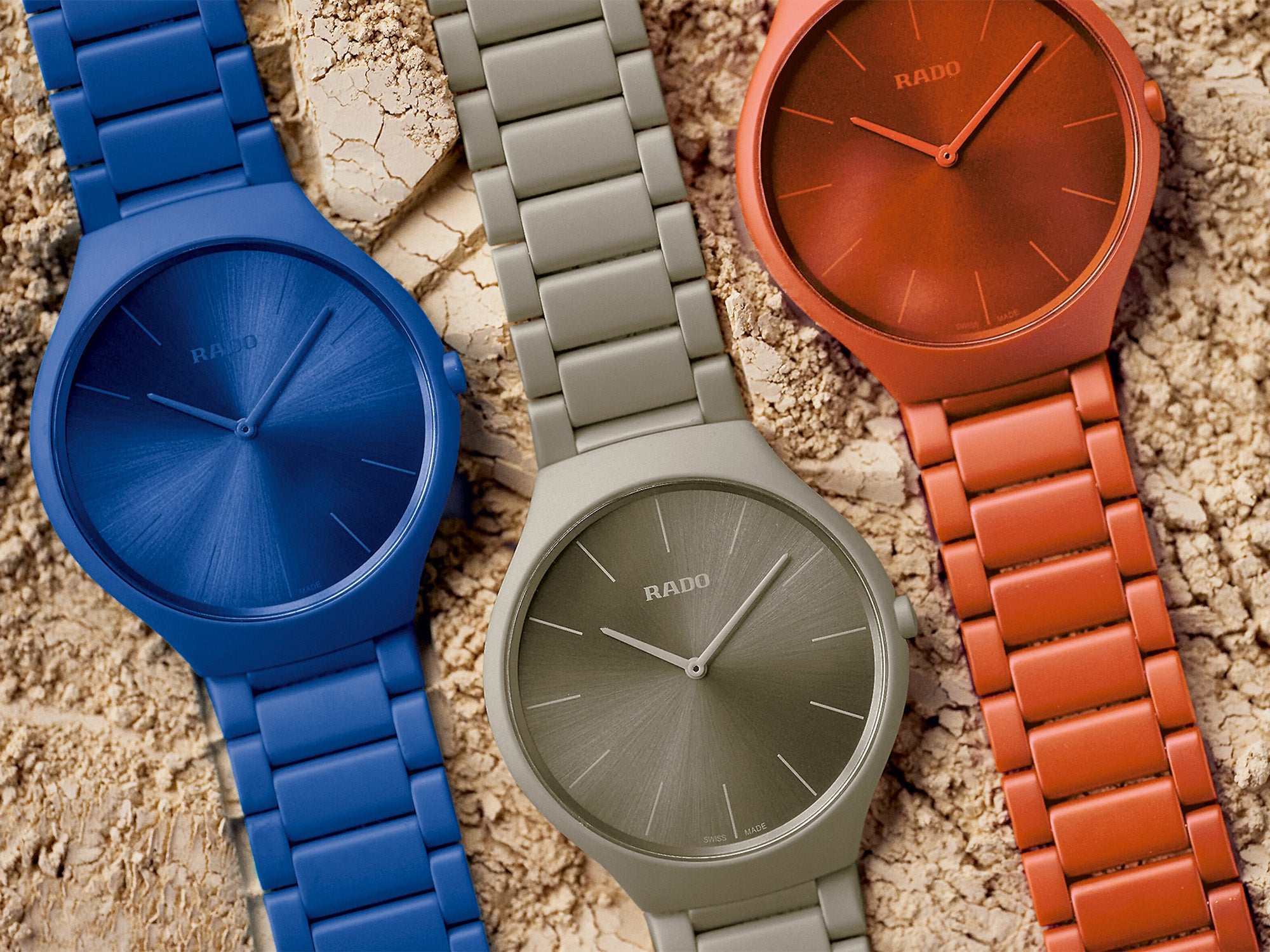
Rado challenged a new technical frontier in 2011 with the development of Ceramos, a hard, highly lustrous ceramic-and-metal composite material that opened the door for a range of different shades of color. Engineered to combine “the sheen of metal and the hardness of high-tech ceramic,” the material was first used in a 1993 model called the Sintra; nearly two decades later, Rado’ braintrust had superseded the press-molding process used to make the original with the more modern injection-molding process used for its high-tech ceramics. The original Ceramos recipe called for 90 percent titanium carbide in the powdered mixture, which made the substance substantially harder even than high-tech ceramic (1,750 on the Vickers scale) as well as being much lighter, all while boasting the same scratch-resistant surface and lustrous sheen. This titanium-dominant Ceramos produces a metallic golden color; adjusting the proportions of metal to ceramic produces other metallic hues.
Return of the Captain
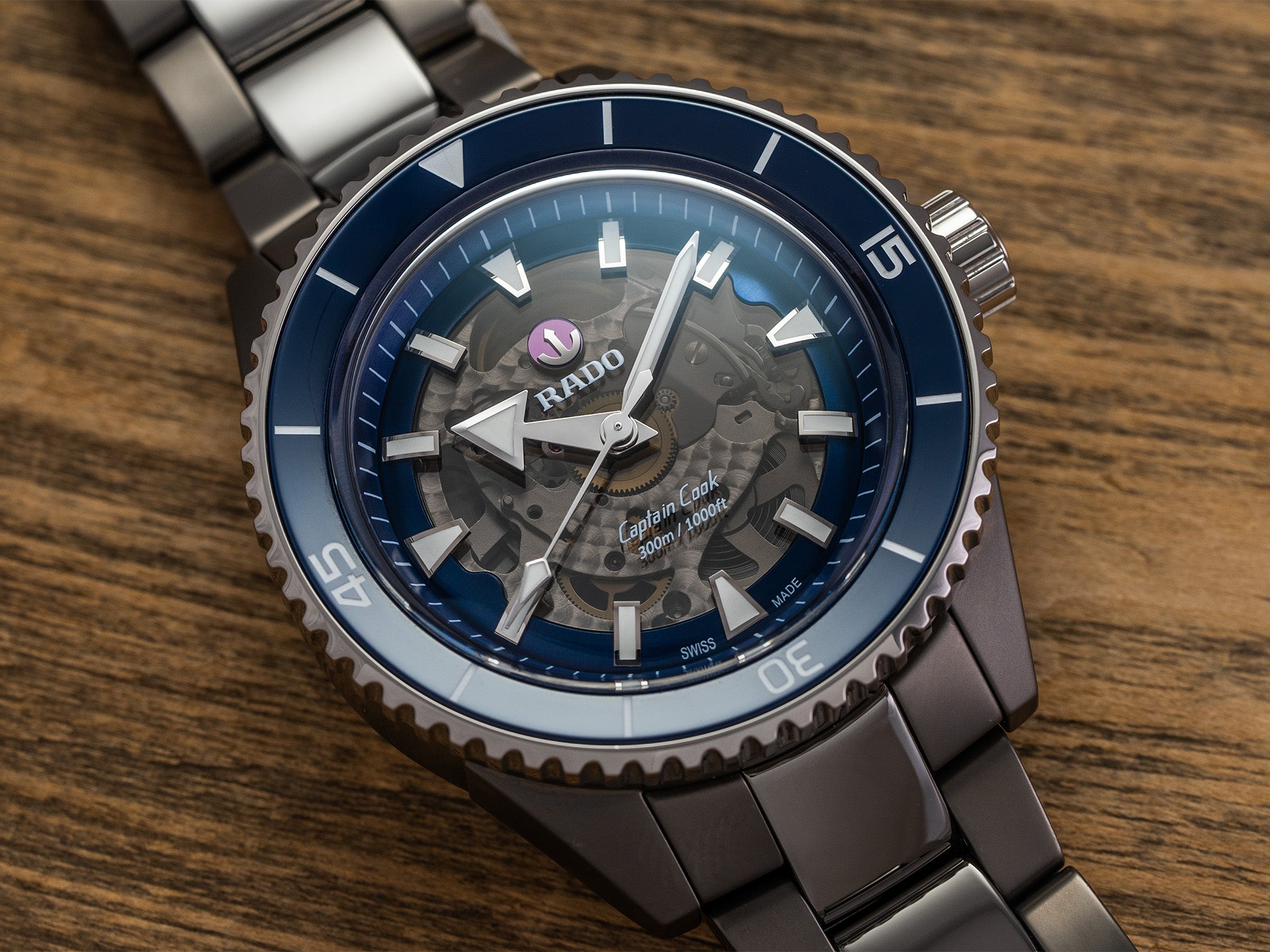
In 2017, proving that you can’t keep a good watch design buried no matter how few people remember it, Rado made the bold move to resurrect its 1962 diver, the Captain Cook, originally as a part of its Hyperchrome collection, then shortly thereafter as a standalone line within the brand portfolio. The sporty, defiantly retro Captain Cook was a departure from the artistic, minimalist DNA that Rado had established for its watches in the decades since the release of the Ceramica, and it found an avid audience amongst a generation of watch enthusiasts who appreciated both its vintage look and its very accessible price point, The Captain Cook has now risen from its humble beginnings to become an undisputed leader of Rado’s modern collection, as well as a sportier showcase for the brand’s materials technology (you can read much more about the Captain Cook collection here).
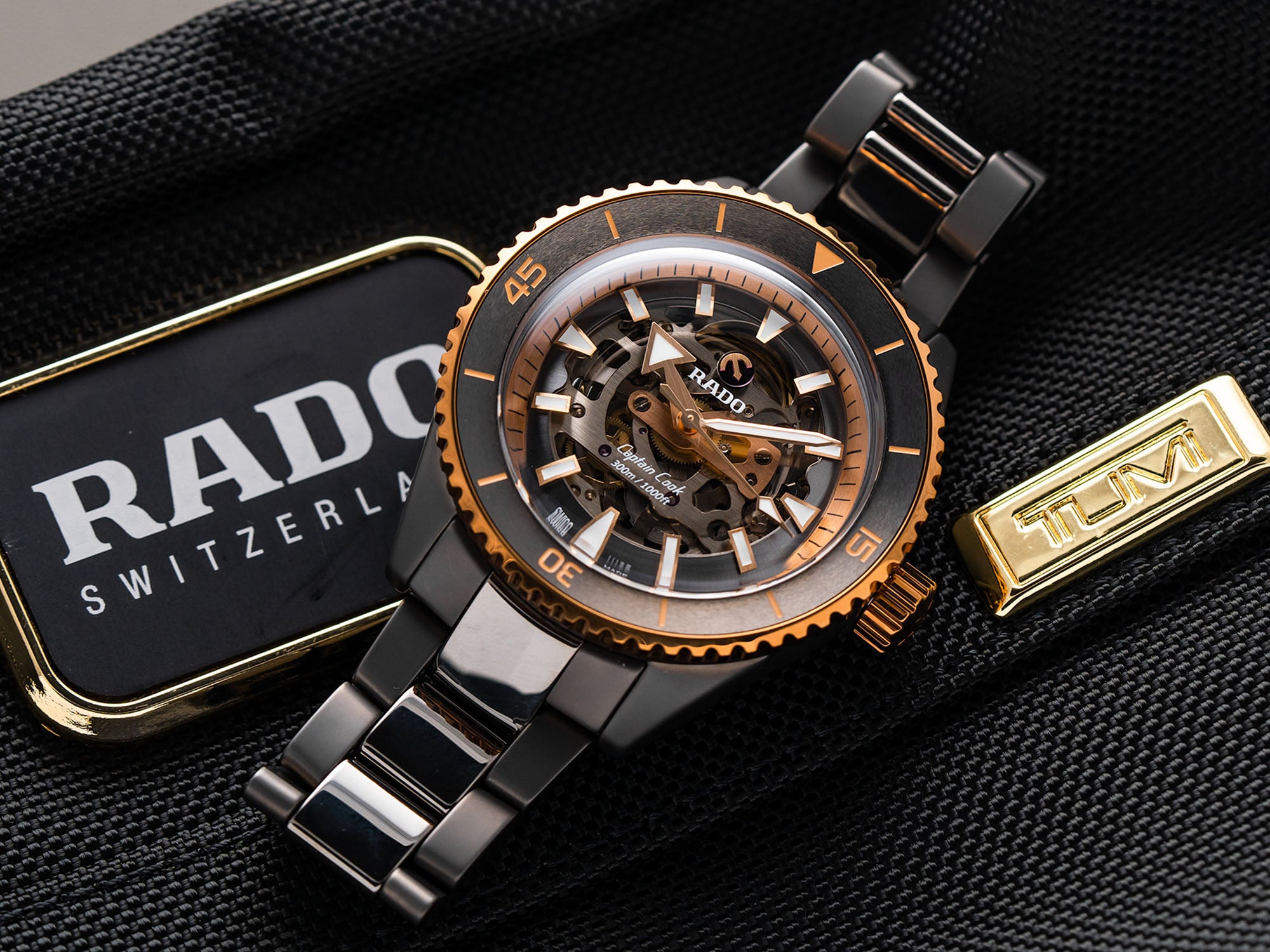
The earliest versions of the Captain Cook featured ceramic inserts for its rotating dive-scale bezels. Considering its history, it was probably inevitable that Rado would eventually also create a version of the Captain Cook with not only the bezel but the entire case made fully from its own “high-tech” ceramic. That model, the Captain Cook High-Tech Ceramic, made its debut in 2021, with a 43mm case made from a monobloc of the eponymous material. The watches featured here use high-tech ceramic for both the case and bracelet, as well as the dive-scale insert of the unidirectional bezel, which is made from stainless steel. The case uses panes of tinted sapphire for the crystal in front and for the exhibition window in the back, both offering views of the movement inside, Rado Caliber R734, which is a skeletonized version of the Powermatic 80 movement found in many other Captain Cook models. The movement also incorporates a Nivarox hairspring that helps protect its inner workings from magnetic fields. The clear dial’s wide arrow hands and indexes are filled with white Super-LumiNova, and the Rado rotating anchor symbol — a hallmark of the 1962 original — occupies its familiar spot at 12 o’clock. One year after the debut of the High-Tech Ceramic models came the Captain Cook High-Tech Ceramic Diver (featured in its monochromatic olive-green version below), which differs from its predecessor only in its use of a solid dial rather than a sapphire openworked one. Thus do two forward-thinking initiatives from "Master of Materials" Rado in the landmark year of 1962 — the development of the DiaStar's composite-material case and the launch of an accessible, smartly designed dive watch — find a perfect synergy in the 21st Century.




















































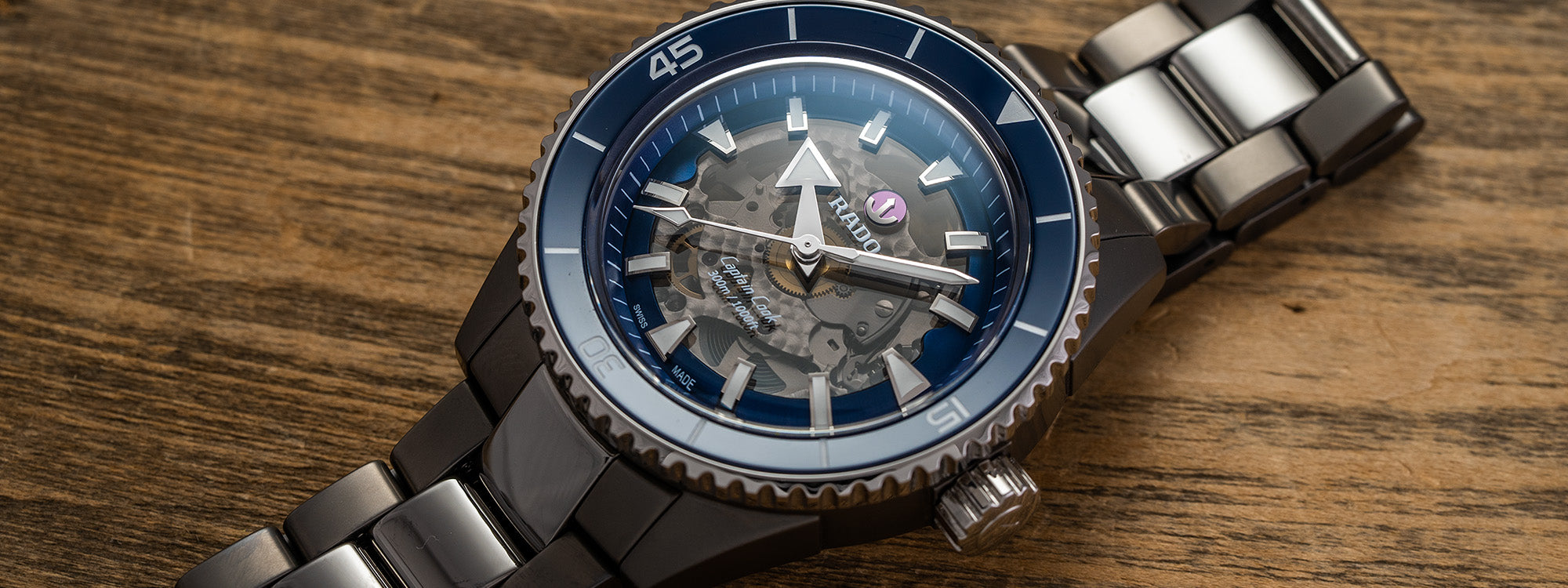


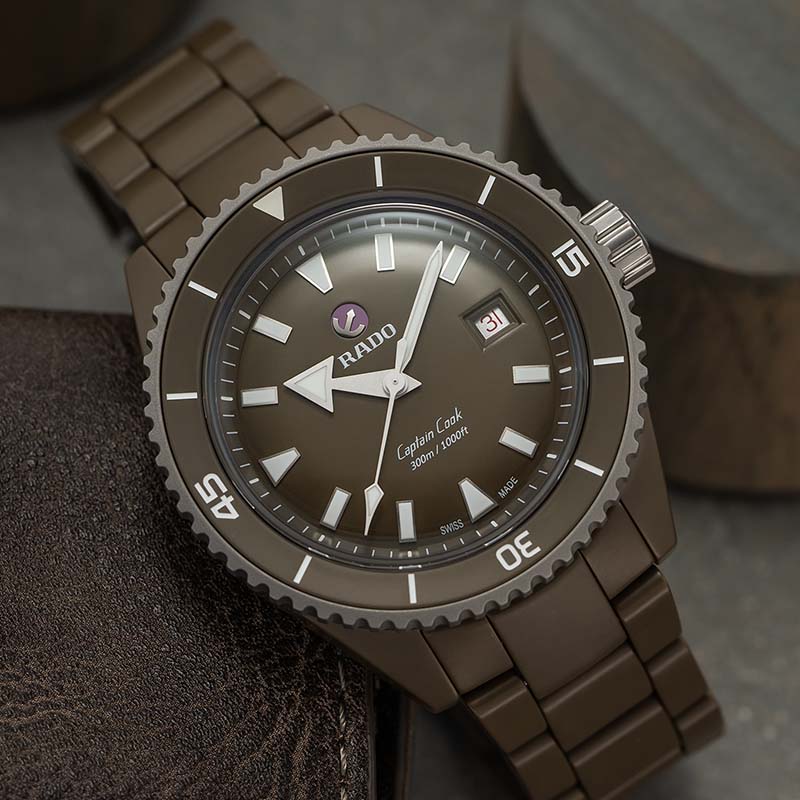
0 Comments